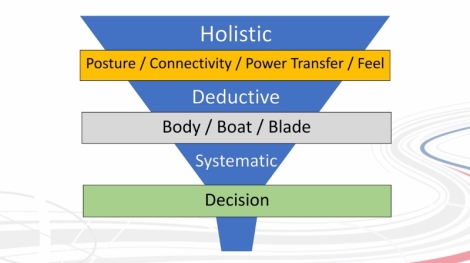
Coaching is often described as being all about making decisions. Deciding what is going on when observing a paddler’s performance. Deciding what interventions we as coaches might offer. Deciding how best we might present those potential interventions.
Through our coach training we are taught to recognise that decisions are sometimes made very quickly (naturalistic decision-making or fast time thinking) while on other occasions we are able to pause and consider our options (classic decision-making or slow time thinking). Our ability to make those decisions is then linked both to our understanding of the performance and our experience of how it might be improved.
The range and variety of factors that go into decision-making can make the whole process seem bewildering to those just starting out on their coaching pathway. One way of helping make sense of this is putting all of this through a decision-making funnel.
The mouth of the funnel is very broad. This is where we take a broad, overall view often referred to as an holistic approach. We watch a performance and compare it to our understanding of what we expect to see – our ‘technical template’ for that particular stroke or skill. Very often something will jump out at us, perhaps the head looking the wrong way or the blade going into the water in the wrong place or at the wrong angle. We are able to make a quick decision about what to work on with that paddler and how best to present that to them.
Sometimes however that holistic approach is not enough. We can see that something is not quite right but can’t immediately identify what it is. We need to narrow down the options and go further down the funnel. It is here that our understanding of the fundamentals of paddling come into play – does the paddler have an active posture, are they connected effectively with their craft, do we see an efficient power transfer and what do they, and we, feel? With experience we learn to go through this checklist pretty quickly and we may be able to make a deduction, an informed guess, as to what the problem is. But if not this is when going to the narrowest part of the funnel can help, when we take a more systematic approach using our three ‘B’s – Body, Boat/Board, Blade – framework.
If what to work on wasn’t clear at the outset or didn’t emerge as we went through our options it should, by the time we’ve completed all of our analysis, just drop from the bottom of our decision-making funnel.
